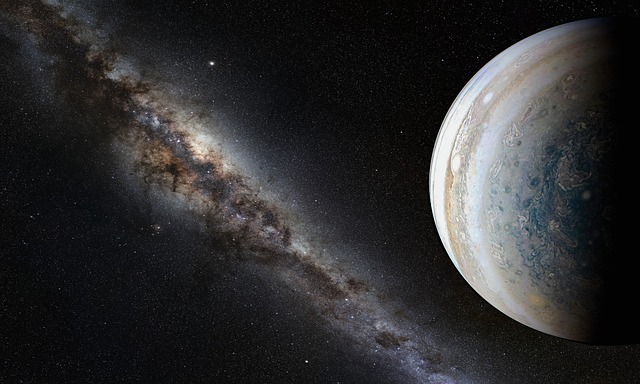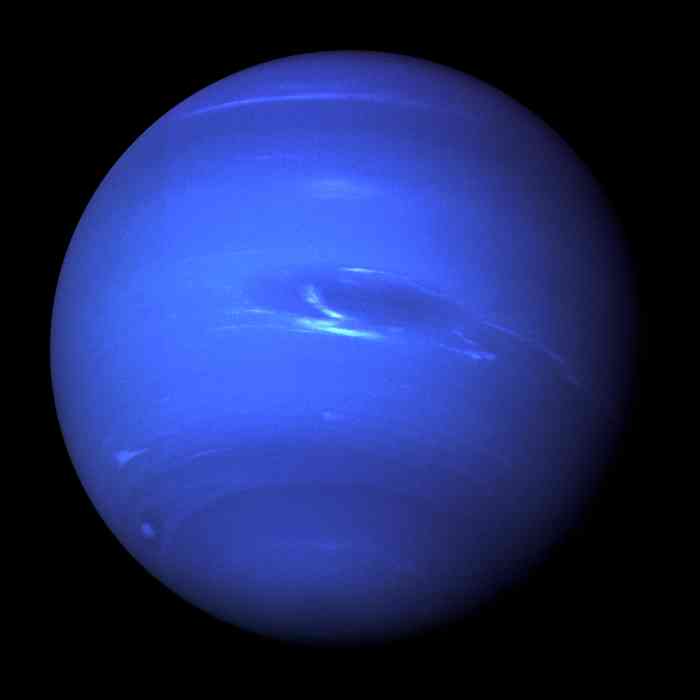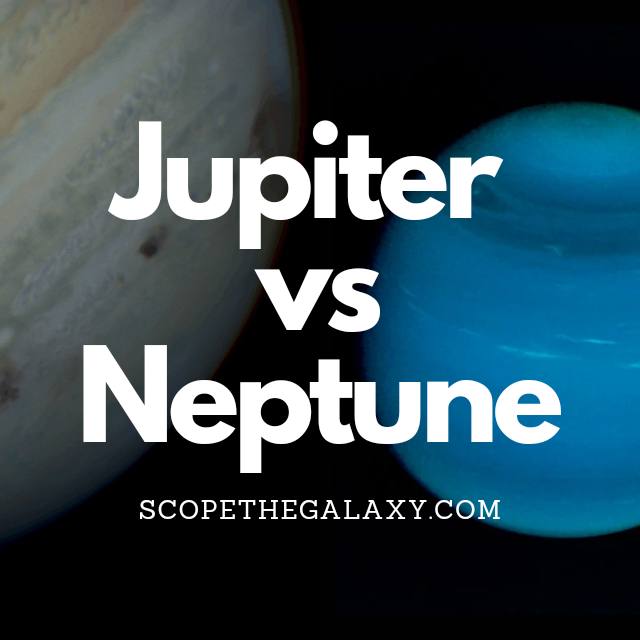*This post may contain affiliate links. This means we may make a commission if you purchase an item using one of our links*
Neptune is the the 4th largest and 8th farthest planet from the Sun whereas Jupiter is the largest and 5th farthest planet from the Sun. Neptune is colder resulting in a water and ice based composition, which is why it’s referred to as an ice giant whereas Jupiter is mostly gas based. Jupiter has more moons orbiting it, with 79 whilst Neptune has 14.
There are a variety of other differences between Jupiter and Neptune so continue reading for a more thorough breakdown on both of these celestial bodies.
What Is The Planet Jupiter?
Table of Contents

Jupiter is the 5th farthest planet from the Sun and the largest planet within our local solar system. The planets most recognizable trait is the giant red spot visible on its atmosphere along with the brown horizontal bands flowing across its atmosphere.
As a result of its composition and size, Jupiter falls under the classification of a gas giant.
This is because its composition mostly consists of the elements hydrogen and helium. The split is roughly 71% hydrogen, 27% helium, with the remainder of the elements split throughout the left over 2%.
As the biggest planet in our solar system, Jupiter is 139,820 km or 1,300 Earths in diameter, it has a mass of around 0.001 solar masses, the temperature when inside the clouds are roughly -145 degrees Celsius whilst the core is far hotter, equating in the region of 24,000 degrees Celsius.
Due to its extreme circumstances, gaseous composition and distance from the Sun, the planet is not theoretically capable to support life, from its subzero temperature to the extremely fast 640 kmph winds, and its gravity which may be unsustainable for our bones, roughly 2.4 times greater than Earth’s.
Although the conditions on Jupiter aren’t suitable for us, some of its 79 moons like Europa for example could support life.
This brown giant has a relatively fast rotation around its axis where 1 rotation typically takes 10 hours to make whilst its orbit around the Sun is far longer taking in the region of 12 years for 1 full cycle.
Another feature of Jupiter that is renowned by astronomers is the strength of its magnetic field. In comparison to the other planets in our solar system it is even stronger than our Sun, where it’s over magnetosphere is roughly 20,000 times the strength of Earth.
What this means is that Jupiter’s magnetosphere is able to avert solar winds that are 3 million kilometers away from it.
What Is The Planet Neptune?

Neptune is the 8th farthest planet from the Sun and ranks among the bigger planets in our solar system. As the 8th farthest planet from the Sun, it does take Neptune a very long time to complete 1 orbital cycle around the Sun.
This takes 165 years to complete which is far longer than the 16 hours needed to complete 1 full day/full spin around the axis.
In regards to its composition, Neptune is mostly made up of a thick swath of water closer to the center, methane, ammonia, hydrogen and helium molded around its Earth sized core.
As a result of the excess amount of methane and the inclusion of another undiscovered element within the atmosphere, Neptune’s color is a far deeper blue than the likes of Uranus, which also has a methane based atmosphere.
The planet is 49,244km in diameter, making it roughly 4 times Earth’s diameter, and would allow around 57 Earth sized planets to fit inside it. This also makes Neptune the 4th largest planet in our solar system.
Neptune is very cold, which is mostly down to its distance from the Sun, where its atmospheric temperature sits between -220 to -230 degrees Celsius. Its core is far hotter coming in at 5,100 degrees Celsius and is the very likely cause for the liquid water present within the planet.
Subsequently, the erratic temperature and gaseous composition of Neptune, is what constitute towards its turbulent behavior.
In fact Neptune has the fastest winds in our solar system, producing some that eclipse speeds of 2,000km per hour. The fastest winds on Earth would only be a fifth of these speeds at most.
At this moment in time we have discovered 14 moons orbiting Neptune and have also observed 5 thinner rings surrounding the ice giant.
How Are Jupiter And Neptune Similar
There are a fair few similarities between Jupiter and Neptune although they are more different than similar. Below I’ll be going over the various similarities these two planets have:
- Both planets are generally composed of hydrogen and helium.
- Both planets are orbiting the Sun.
- Both have hotter central core.
- Both have multiple moons.
- Both have rings around them.
- Both are spherical in shape.
Differences Between Jupiter And Neptune
As for the differences between the two, they would include the following:
- Jupiter has 4 thinner rings whilst Neptune has 5.
- Jupiter has 79 moons whilst Neptune has 14 moons.
- It takes Neptune 165 years to orbit the Sun whereas Jupiter can do this in a far shorter 12 years
- Jupiter is the largest planet in our solar system whereas Neptune is the 4th largest. For comparison around 1,300 Earth’s can fit within Jupiter whereas 57 Earths can fit into Neptune
- Neptune is colder at -220 to – 230 degrees Celsius whereas Jupiter is -140 to -150 degrees Celsius. Jupiter’s core is 24,000 degrees Celsius and Neptune’s is a cooler 5,100 degrees Celsius.
- Neptune has the fastest winds on any planet within our solar system hitting 2,000km per hour whilst Jupiter’s wind speeds are around 640 km per hour.
- Neptune is blue in color whereas Jupiter is a light and dark brown color.
- Jupiter completes one rotation around its axis every 10 hours whilst Neptune does so every 16 hours.
- Neptune is the densest giant planet in our solar system.
- Jupiter has a far stronger magnetosphere than Neptune.
- Jupiter is older than Neptune by 100 million as it has been around for 4.6 billion years as opposed to the 4.5 billion years Neptune has.
Summary
Neptune is the bluest and coldest planet in our solar system whilst Jupiter is the biggest and heaviest planet within it. As a result of its size, Jupiter does have a far stronger gravitational pull and magnetic field although Neptune is the denser of the two giants.
As a whole both planets have a many similarities but they are certainly more different than they are similar.


